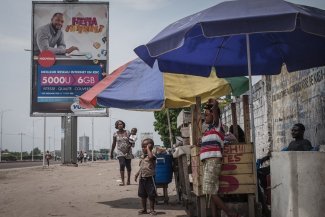Cement factories and incinerators are often located in the poorest parts of cities.
Three letters changed the history of Warren County, North Carolina, in 1982: PCB. This abbreviation stands for polychlorinated biphenyls, a family of toxic chemical substances that, according to the World Health Organization, can cause reproductive and developmental problems, damage the immune system, interfere with hormones and also cause cancer.
At the end of the 1970s, 100,000 litres of this toxic material was dumped along roadsides in North Carolina. The government decided to bury it all underground. The location chosen was Warren, a community with the highest percentage of Black residents in the whole state.
It was not coincidental, it was racism.
The inhabitants of Warren were the first to stat that they had been the victims of ‘environmental racism’, a form of discrimination that was, in fact, spread across the United States, where over 15 million African-Americans and eight million Latinos were living next to polluting factories, Black children had higher blood lead levels than White children, and where being a different colour meant you would live eight years less, on average.
“If you want to know where waste is most likely to be dumped, ask yourself where Blacks, Hispanics, Native Americans and other racial minorities live and where the poorest neighbourhoods are,” said European sociologist Razmig Keucheyan in his essay, Nature is a Battlefield.
Today, Black populations are not the only targets of environmental discrimination. It also targets Latino, Indigenous, migrant, Roma and poor communities. According to the most recent study of the United States Environmental Protection Agency (EPA), those living below the poverty line breathe in 35 per cent more pollution than the rest of the population.
Pollution is never impartial, nor are those who decide where to put the factories, the incinerators and the nuclear waste disposal sites.
“When companies or institutions are installing polluting structures, they look for the cheapest areas, and that’s often where the most vulnerable populations live: racialised people, the poor, migrants, most of whom are women,” explains Yayo Herrero, an anthropologist and director of the Fuhem Foundation.
That is why one in four Roma in Europe lives in areas affected by pollution, poor hygiene or environmental problems. Those living in the Czech Republic or Spain are amongst the worst affected.
It is the most unjust flipside of progress. We all pollute: we generate tons of waste and consume thousands of kilowatts to feed the technological architecture that underpins our lives. But not all of us are poisoned by the toxic consequences.
“When all the infrastructures are placed in certain areas and others are spared, inequalities are created,” says Alodia Perez, head of the natural resources and waste department at Friends of the Earth Spain. She also points to the deliberate nature of this unequal distribution: “Industries choose impoverished areas because they know that there will be less of a public response, that they will come up against less resistance.”
A silent threat
Between 3,000 and 4,000 tons of waste enters the Valdemingómez incineration plant, in Madrid, every day. There is always part of the waste amassed that cannot be recycled and ends up in a furnace, where it burns at a temperature of around 850˚C. This combustion process generates electricity, but also toxins, heavy metals, and ash.
“It is imperceptible on a day-to-day basis. The emissions do not smell, there is no cloud of smoke coming out of the chimney, but all the scientific studies say that breathing the air of an incinerator causes different types of cancer,” says Enrique Villalobos, a local residents who has for years been campaigning for the closure of the plant, and all the more vigorously now that the contract is due to expire in 2020.
Although there is no specific information on the health effects of the Valdemingómez incinerator, a study by the Carlos III Health Institute, of Madrid, confirmed, in 2012, that incinerators kill. It has been demonstrated, for example, that in the case of some types of cancer, such as that affecting the pleura or gallbladder, the mortality rate is higher amongst people who live within five kilometres of one of these monumental crematoriums. “It is a kind of silent death,” insists Villalobos.
Here, as in Warren County, there is nothing coincidental about the location of such sites.
“In Madrid, the factories, incinerators and dumps are concentrated in the south-east of the capital. They are not, of course, installed in well-to-do areas, but in those with the highest levels of poverty and migration,” explains Perez.
Indeed, the 800 families on the first line of containment in Valdemingómez live in the largest informal settlement of Europe, Cañada Real Sector 6. Its inhabitants are the socially excluded, Roma and migrant families from Morocco and Romania.
“Some do-gooders may say that pollution and air quality affect us to all the same. But they do not realise there is a class bias, and that it is very deeply ingrained,” says Herrero.
Many companies also play on the needs of the poor, forcing them to choose between a healthy environment and employment prospects. Some call it “environmental blackmail”: I promise to give your children work in return for you accepting a nuclear waste dump on your doorstep.
“We have internalised the belief, as a culture, that what people need is money, rather than to be able to breathe clean air, that everything is worth sacrificing as long as the economy grows. It’s warped,” laments Herrero.
The resistance movements
In 1982, the residents of Warren came together on the roads leading to the county and laid on the ground to block the access of the trucks loaded with PCB. Over 500 people were arrested. It was the start of a movement, inspired by the civil rights movement led by Dr Martin Luther King, to demand the right not to be poisoned. The pressure was such that the government of the United States was prompted to set up the first Office of Environmental Justice (an institution now at risk of being cut back by the Trump Administration).
“The important thing about this movement is that it is led by the people directly affected, by the impoverished people,” says the director of Fuhem. “In Europe, the mobilisations are limited to the environmental movement. It’s as if the majority population hasn’t realised that it will end up affecting us all.”
Breathing air that does not poison us, drinking lead-free water or living in an area without fear of an increased risk of cancer are rights recognised by United Nations. The problem, as environmentalist lawyer Xavier Ezeizabarrena points out, is that “the environment is not one of the first generation of fundamental rights. Legislative development is still needed to ensure adequate protection, and above all, to ensure compliance.”
Thirty-six years after Warren, the environmental justice movement is now spreading across the world. In 2014, an online atlas was created, mapping almost 2,500 active resistance movements.
They are fighting against extractive projects, palm plantations or the illegal drilling still affecting the most vulnerable communities. It is a world map of the environmental racism that is increasingly being shifted to the South, to places like the Amazon rainforest of Peru or the Niger Delta, continuously polluted and plundered to satisfy the needs of the North.
“Our level of consumption is constantly on the rise, and there is more and more waste,” insists Perez. “It is a problem that is going to keep growing.” And for as long as the factories are not redistributed, for as long as the smoke only affects certain areas, some will suffer the consequences of this growth before others.
According to the latest figures of the WHO, some seven million people die as a result of environmental pollution every year. Over 90 per cent of these deaths are in low- and middle-income countries. And it is no coincidence.










